A series of career steps in arts administration and management led Mykal Urbina to the Center for Latter-day Saint Arts, a nonprofit organization committed to displaying and performing art by Latter-day Saints from around the world and sharing it with the broader public. She was recently named Executive Director.
Tell me about how you came to work in management in the arts.
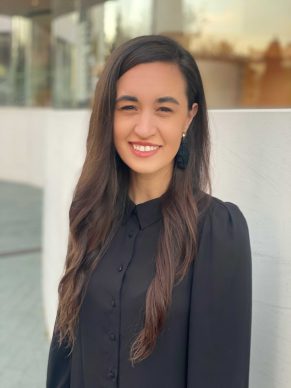
Mykal Urbina
I grew up in Gilbert, Arizona through high school. I went to college in upstate New York in Ithaca, which was a departure from what I was used to in every respect – the weather and community and political leanings – it was a culture shock for me. But I absolutely loved being in New York and being in a very different environment. I studied nonprofit marketing and after my four years in school, I moved to New York City to pursue my career.
For the first five years, I worked for a crowdfunding platform for public school educators called Donors Choose, doing fundraising and sponsorships. I loved it largely because it showed me the power of a singular voice and a personal story. On that site, individual public school educators are invited to post requests for classroom materials they need, and donors can fund specific projects. I loved that it added tens of thousands of perspectives to the educational conversation directly from the classroom and that I got to be part of supporting teachers and elevating those stories. That became very important to me. I noticed that the projects that I loved helping fund were those that exposed students to the arts, took classes to see The Nutcracker, or brought musical instruments into the classroom. I realized that I wanted to take my personal passion for the arts and translate it into my professional life.
So I accepted a position with the New York Philharmonic at Lincoln Center to run their corporate sponsorships team. It was an absolute privilege and an honor to have an office at Lincoln Center, to work for a world-class arts organization with such a storied history, to see the inner workings of an organization with that kind of legacy.
I realized that I was missing the community piece and wanted to bring that back into my daily work, so I moved to Orange County, California to lead the corporate and foundation relations team for the Segerstrom Center for the Arts. It’s one of the largest arts education providers in the country and they’re doing groundbreaking work in community involvement with free community events for under-represented communities, for children, for youth, for families. I loved getting to be part of that and learning from that.
Then the opportunity arose to become more involved with the Center for Latter-day Saint Arts with which I’d been volunteering for a couple of years. Looking back, the three dream jobs in a row that I had were all leading to this unique intersection of my personal and professional passions. It felt like an opportunity that was divinely designed for me and was the next step I needed to take in my career. So I came back to New York. Back to Lincoln Center. When I worked at the New York Phil, I used to get lunch at the deli across the street that is now the Center Gallery for the Center for Latter-day Saint Arts.
Coming full circle! Not just in the area, but literally the exact same location. You said you combined your professional pursuits with your personal passion for the arts. What is your personal passion for the arts?
In a past life, I played the piano and the violin. I still play the piano. I danced with a pre-professional ballet company for many years. But it was pretty evident by the time I got to the college level that my skills were better suited to the kind of choreography and orchestration that happens behind the scenes, in arts administration. I’ve always loved the arts, I’ve always participated in the arts, I’ve been an advocate for the arts, especially in public school education. I knew my role was to be behind the curtain and champion the arts from a fundraising and administrative perspective, so that’s where I’ve made my career.
I think there’s so much to be learned and expressed and understood in a way that only art can fill. That’s the power of art – to express what we can’t put into words and feelings that are extremely complicated and complex, and may not have a resolution at this point. Art is an opportunity to explore those in a new way.
What was the intention for creating the Center for Latter-day Saint Arts, and the reasoning to have the gallery in New York City rather than in Utah?
The Center Gallery is a project of the Center for Latter-day Saint Arts. The goal was to have a physical gathering place to celebrate with the community, to host fine art exhibitions, to have lectures and performances, and just be a physical meeting ground for the connection point that is the arts. It’s really been a privilege to watch the gallery grow. It was difficult because we opened during Covid so physical gatherings were limited. But eventually, we launched a series of Friday night, free community events spanning everything from readings to live music performances to artists talking about their work and the development of their art. It’s had such an incredible community response.
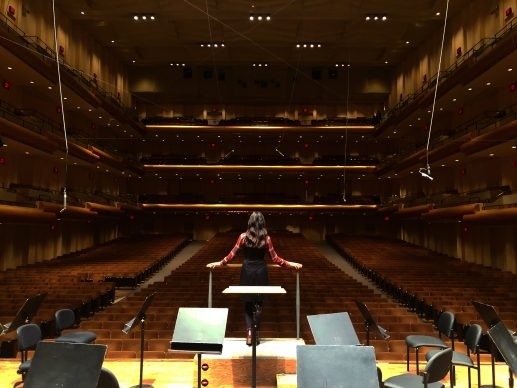
Mykal Urbina at New York Phil
I think the goal was to have a space in New York at Lincoln Center, which is a cultural hub of the world, across the street from the Met and New York City Ballet, and the New York Phil. It’s such a unique location in the heart of Manhattan to celebrate the Latter-day Saint art community. It shares the façade of the building with the Manhattan Temple – it’s such a beautiful and perfect space to celebrate the artistic heritage and contemporary art of our Latter-day Saint artists.
It’s technically in the same building as the temple – any time Church members do a session at the Manhattan Temple, you’re right there, literally downstairs.
To date, about sixty percent of the gallery visitors are community members, not members of the Church. So for us, it’s an artistic version of a visitor’s center. It’s certainly a destination for local ward groups, visitors coming to the temple, and visitors to Manhattan attending church in the temple building. The gallery is open on Sundays so that it can be a resource for those who are coming to church. But it’s been a special space that gets a lot of foot traffic from art lovers who wander in and are surprised and delighted by what they see and the relevance it has.
I know you recently had an exhibit (January-February 2022) about Heavenly Mother. If sixty percent of the gallery visitors are not members of the Church, what was the reaction to that art?
It was a very, very positive reaction all the way around. The title being, “The Sacred Feminine in LDS Art and Theology” upends expectations about some of the cultural stereotypes of the Church. There’s warmth and excitement to see this type of work and work with this kind of feminist tone displayed in association with Latter-day Saint theology.
From members of the Church who visit the exhibit, there’s an overwhelming sense of peace and being seen and understood and represented in the art that’s being displayed. I think what’s special for everyone who comes in, is that this work is so extremely diverse and global in its nature. There’s work from Argentina, Canada, Mexico, and Nigeria. There’s Native American art. It really speaks to a very broad and diverse audience, regardless of their entry point to the gospel or their familiarity with LDS theology.
All of the art and all of the wall text are on our website. Many of my friends and family on the West Coast are simultaneously relieved that this kind of exhibition is happening, so thrilled that it exists, and desperately frustrated that they couldn’t see it in person.
This exhibition predated me. It was designed by our brilliant gallery manager, Glen Nelson, and his gallery committee long before I was part of the picture. It was especially impactful for me to come in and see something that I care so much about represented in this organization and was certainly part of why I was excited to get on board.
What was your personal reaction to the Heavenly Mother exhibit?
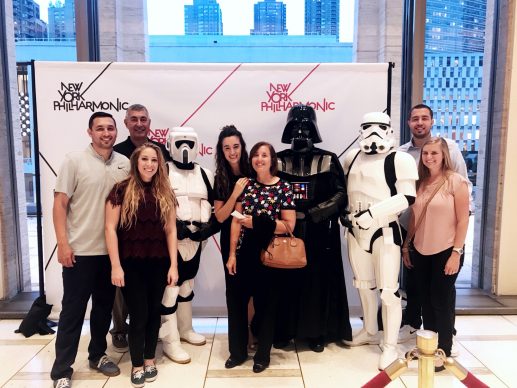
Mykal Urbina with Her Family
The doctrine of Heavenly Mother is something that I’ve studied personally for a long time. My feeling about this topic is that we’re seeing such a surge of interest in the doctrine of Heavenly Mother, within the Church especially. I taught Relief Society a couple of weeks ago and there were at least three comments that just naturally referenced our Heavenly Parents and Their love for us. When I was in Young Women, those were not references that were made. So to see doctrinally sound, artistic representations of this topic is very refreshing to me and it’s something that excites me about where we’re headed with these conversations.
Where do you think we’re headed with these conversations? I can’t quite tell.
I can’t either. In my studies of Heavenly Mother, in all that I’ve read and all that I’ve learned, I think my favorite point of reference is from President Hinckley who said that logic and reason suggest that if we have a Father in Heaven, we have a Mother in Heaven, and that doctrine rests well with him. There are certainly some things within the Church that don’t always rest well with me, but this one does. This one brings a lot of peace and I hope that we learn more. I hope that there’s revelation to come, but even if not, this doctrine resonates with me personally.
You said that the exhibit included art from multiple countries – how did you find those artists and their work?
Margaret Olsen Hemming, who curated the Sacred Feminine show, has a very rich network, particularly regarding this topic of the divine feminine. She brought these amazing artists together. Richard Bushman and Glen Nelson, the co-founders of this organization, also have a deeply rich network of artists and connections within the arts community. We have an advisory board that includes a number of artists also sharing the work they’re becoming aware of and referrals to artists in other countries.
The Center has done a couple of calls for submissions on specific topics – we did one in the early months of Covid about artistic expression of the pandemic and the experience of the pandemic. We did a call specifically for BIPOC creators. Both calls brought new artists to us and are helping expand our reach. The area of opportunity I’m most excited about is bringing that global perspective and elevating artists outside the United States. We’re working on some projects to start finding and unearthing the art by Latter-day Saint creators internationally and making them available as a resource to the Church, to our audiences, members of our faith, and beyond.
That is fantastic. Do you have a personal goal that you want to accomplish with the Center, or are you working toward goals that Richard and Glen have already set?
Richard and Glen have built this incredible organization based largely on curiosity and exploration, and the belief that good art and stories and important conversations come from everywhere. That’s a tradition I’m excited to continue and hopefully complement with my own experiences and my own perspectives. I’m excited to partner with them in that effort.
My goals for the Center personally are two-fold. I would love for the Center to be a resource to members of the Latter-day Saint community, to broaden their identity in the Church through art; to give another lens and another angle for grappling with the conversations within our community every day – social issues, issues of diversity and inclusion, of faith and heritage within our community. All of the ways we interpret those things can be beautifully expressed through art. I want to help members be aware of and proud of our cultural identity. Second, for those who are just learning about our faith or are interested in learning about the gospel – I’d like to expand their expectation of who we are and our relevance in the world, and the contribution we make to the larger faith community.
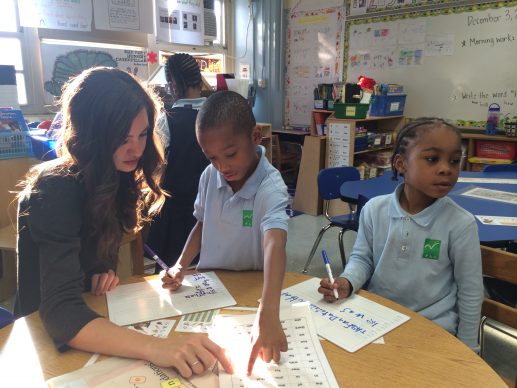
Mykal Urbina at Donors Choose
One thing I love about the Center is that there are so many entry points to understand that art has significant value. Some art will touch some people that may not reach others, and perhaps those individuals haven’t found their entry point yet. Some people feel the Spirit through music, some feel it through dance, some through the written word. I think there’s an exploration that needs to happen. I’ve never met anyone who couldn’t find inspiration and connection and value in one form of art or another.
How do you understand and define our cultural identity?
So many of my peers are choosing to step back or away from the Church and the reason why that I hear most often is “church culture.” That’s challenging for me because when we talk about church culture, I think of the social culture of the Church. There’s so much to be proud of and inspired by and connected to in our artistic legacy, in our artists, our dancers, our composers, our poets, our authors. There’s a richness to who we are and the way we express where we’ve been and where we’re headed that I believe should be a point of pride. I’d like to see us shift the language of what “church culture” is to something that’s very inclusive, very expansive, and encompasses more than just the social conversations that are happening.
I think the word “culture” is the filler word for customs and behavioral patterns that at one point may or may not have been declared as doctrine. It summarizes in one word all the random things that we do that are just things that we DO, they’re not our teachings. That’s how people are using the word “culture” but I like your definition much better and I think it’s more accurate. We need a different word than “culture” for behavioral traditions, but right now we don’t have one.
I completely agree. I was at the opening of the Center Gallery several months ago and the lead curator for that exhibit talked about how contemporary art and modern art can be an opportunity to use the Holy Ghost and be an experience of faith that’s testimony building. I think there’s an opportunity for art to fill that space between what we define as culture and what we know as doctrine.
I think we’re also learning as a community that language and representation are important. We’ve seen recent shifts to the Young Women theme – from “We are daughters of Heavenly Father” to “I am a beloved daughter of Heavenly Parents.” That’s an important and significant shift.
I’m reminded of the moment when it was brought into clarity for me how important representation is in the art within our faith. I was a counselor for a youth conference, and I wanted to get my group of Young Women some little tokens and treats and things for the end of the conference experience. I picked out a postcard-sized print of Christ surrounded by young women – it’s a piece I’ve always loved, have felt connected to, and carried in my scriptures. I got copies of that. At the end of the conference, I pulled out all of the things to get ready to give to my girls, and I recognized that the young women in my group were all Polynesian and the women in this painting were all white. In that moment, I thought, “How am I going to give this image to these girls that is completely not representative of them and who they are?” At the same moment, I realized I didn’t know where to turn for more diverse representation.
That’s something I’m thrilled about with the Center, especially with the Sacred Feminine exhibit – the diverse representations of the divine, the diverse representations of members of our faith. Some of the depictions of female deity weren’t people at all – they were symbols or nature. There are so many illustrative representations of Heavenly Mother and our relationship with Her. There’s so much power in that and so much identity to be found in that. That’s extremely important to me.
As people find connection and identity and faith in God through art, is there a specific piece of art that has really touched your heart and strengthened you spiritually?
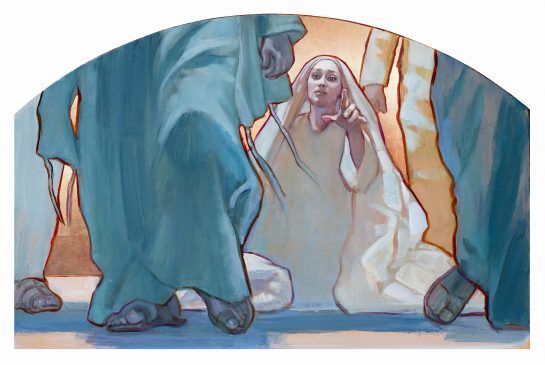
Woman of Faith by Rose Datoc Dall, used with the artist’s permission.
Rose Datoc Dall has a painting called “Woman of Faith,” about the woman with an issue of blood. That’s my favorite New Testament story and she has a beautiful piece of that individual’s experience with Christ. The first time I saw a piece of art featuring that story was in Magdala, Israel. There’s a large-scale canvas – it’s a massive piece – of a woman’s hand reaching out to touch the hem of the Savior’s garment and it absolutely stopped me in my tracks. I had never seen that particular story represented through art, and it was a very emotional experience for me. When I found Rose’s interpretation of the same story, it resonated in the same way. It’s such a beautiful moment. There’s a longing and a hope in that story, and especially in the woman’s expression as Rose has captured it that I think is universal. That’s been a very powerful piece for me.
What’s the intersection between faith and art and your professional life, and how do you put all that together into one big package?
When I was debating in my own mind whether taking on the role of the executive director at the Center for Latter-day Saint Arts was the right position and the right next step for me, someone shared with me a quote that has stuck with me: We should never let our critique of a cause outweigh our contribution.
There’s a lot that I wrestle with within the Church. There’s a lot that I wrestle with in doctrine and in what we talked about with this filler word of ‘culture.’ But I feel a responsibility to contribute where I can. The experiences I’ve had professionally have led me to a place where I feel like I have an opportunity to do something meaningful here, that this particular path has a purpose for me. I’m not entirely sure what all will unfold from this, but I’m compelled to stay, to be part of this community, to contribute in the way I’ve been uniquely prepared to contribute, and to help resolve some of those questions for myself and hopefully pave the way for others to find their own answers. If not answers, then their own faith-building experiences specifically through the arts.
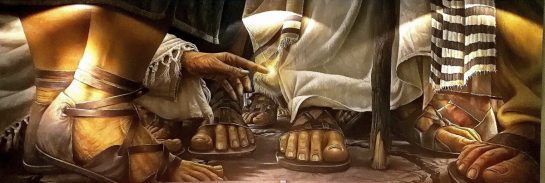
The Encounter by Chilean artist Daniel Cariola in Magdala Israel
At A Glance
Name: Mykal Urbina
Age: 33
Location: Holladay, Utah / New York, NY
Marital History:
Children: None
Occupation: Arts Administrator
Convert to the Church: No
Schools Attended: B.S., Integrated Marketing Communications, Ithaca College
Languages Spoken At Home: English
Favorite Hymn: Because I Have Been Given Much
Website or Social Media You Would Like Featured:: https://www.centerforlatterdaysaintarts.org/
Interview Produced By: Trina Caudle
